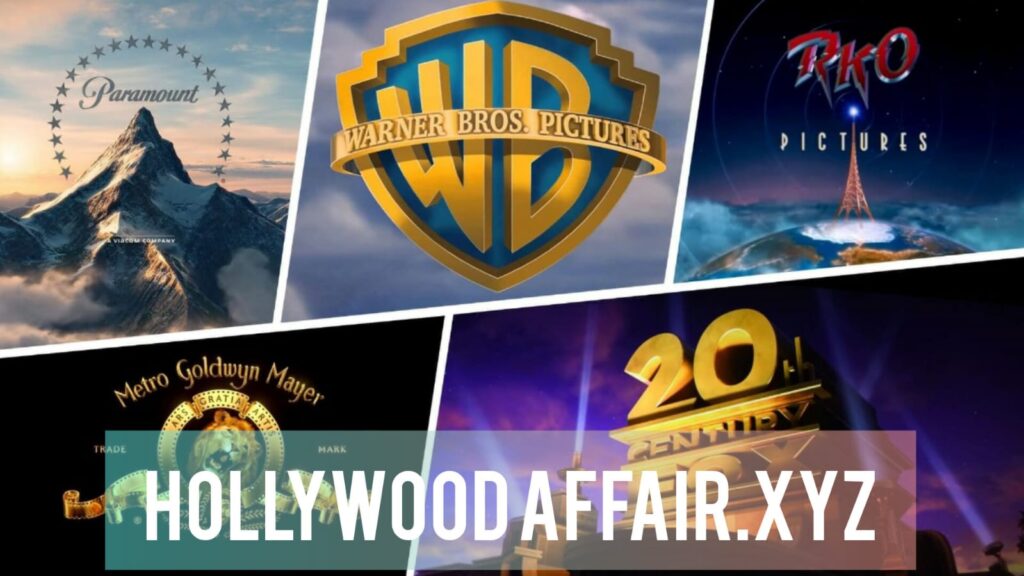The late 1920s and 1930s brought noteworthy innovative developments that revolutionized the film industry. The presentation of sound with “talkies” started with “The Jazz Artist” in 1927. This move required considerable venture in modern hardware and soundproof studios, which the major studios might manage, assist uniting their power.
Color film innovation moreover progressed, with Technicolor getting to be more broadly utilized in the 1930s. Movies like “The Wizard of Oz” (1939) and “Gone with the Wind” (1939) showcased the dynamic conceivable outcomes of color, captivating groups of onlookers and setting unused measures for visual storytelling.
The Huge Five and the Small Three
By the 1930s, the studio framework was ruled by the “Enormous Five” studios:
1. Metro-Goldwyn-Mayer (MGM): Known for its luxurious preparations and steady of stars like Judy Wreath and Clark Gable.
2. Paramount Pictures: Created advanced movies and supported executives like Cecil B. DeMille.
3. Warner Bros.: Specialized in dirty, urban shows and hoodlum films.
4. 20th Century Fox: Consolidated in 1935, known for musicals and movies featuring Shirley Temple.
5. RKO Radio Pictures: Delivered classics like “Lord Kong” (1933) and collaborated with chief Orson Welles.
The “Small Three”—Universal Pictures, Columbia Pictures, and Joined together Artists—were moreover compelling but needed the full vertical integration of the Enormous Five.
Genre Filmmaking and Assembly-Line Production
Studios worked like industrial facilities, creating movies in an assembly-line mold. They specialized in classes that coordinated their brand personality.
For case, All inclusive was popular for frightfulness movies like “Dracula” (1931) and “Frankenstein” (1931), whereas MGM centered on musicals and epics.
This period saw the flawlessness of class traditions and the reliable generation of high-quality movies. Studios controlled each viewpoint, from scripting to set plan, guaranteeing productivity and profitability.
The Hays Code and Censorship
In reaction to open objection over embarrassments and the seen corruption in movies, the Movement Picture Generation Code (Hays Code) was built up in 1930. This self-imposed censorship directed substance, denying express sexuality, over the top savagery, and shameless behavior. Studios followed entirely to the code to dodge government intercession, which altogether affected the subjects and accounts of movies amid this era.
The Decrease of the Studio Framework: Challenges and Changes (1950s – 1960s)
The Affect of Television
The coming of tv in the late 1940s and 1950s displayed a critical challenge to Hollywood studios. As TV sets got to be common in families, motion picture participation declined. Studios may no longer depend exclusively on showy discharges for revenue.
In reaction, studios tested with modern innovations and groups to draw gatherings of people back to theaters. This included widescreen forms like CinemaScope, 3D movies, and epic preparations with pretentious sets and casts.
The Fundamental Decree
A point of interest lawful choice in 1948, known as the Joined together States v. Fundamental Pictures, Inc., constrained major studios to strip their theater chains. The Incomparable Court ruled that the studios’ vertical integration abused antitrust laws. This choice disassembled the studio system’s control over generation, conveyance, and presentation, driving to a more competitive and divided industry.
The Rise of Free Producers
With the decrease of the studio system’s tight control, autonomous makers and littler studios picked up conspicuousness. Producers like Alfred Hitchcock and David O. Selznick worked exterior the conventional studio framework, creating inventive and creatively driven films.
Actors and executives started to look for more imaginative opportunity, challenging the ancient contract framework. Stars like Bette Davis and James Cagney battled for superior contracts and control over their careers, signaling a move in the industry’s control dynamics.
New Hollywood and Imaginative Renaissance (1960s – 1980s)
Breaking Absent from Tradition
The 1960s and 1970s stamped a period of experimentation and disobedience against conventional filmmaking standards. Impacted by European craftsmanship cinema and countercultural developments, a unused era of producers risen, enthusiastic to investigate offbeat stories and techniques.
Studios, battling fiscally, took dangers on these youthful executives, trusting to interface with more youthful gatherings of people. This period, known as “Unused Hollywood,” saw the rise of auteurs who had noteworthy imaginative control over their projects.

Iconic Movies and Directors
Directors like Martin Scorsese, Francis Passage Coppola, Steven Spielberg, George Lucas, and Stanley Kubrick delivered groundbreaking movies that re-imagined cinema:
• “Easy Rider” (1969) by Dennis Container captured the soul of the counterculture.
• “The Back up parent” (1972) by Coppola got to be a benchmark in narrating and character development.
• “Jaws” (1975) by Spielberg spearheaded the summer blockbuster.
• “Star Wars” (1977) by Lucas revolutionized extraordinary impacts and merchandising.
These movies combined imaginative desire with commercial victory, revitalizing the industry.
The Blockbuster Era
The victory of “Jaws” and “Star Wars” driven studios to center on high-concept movies with mass offer. The blockbuster time emphasized exhibition, uncommon impacts, and broad promoting campaigns. Studios contributed intensely in less movies, pointing for huge returns.
This move affected the sorts of movies delivered, with an accentuation on establishments, spin-offs, and stock openings. Whereas beneficial, a few faultfinders contended that it driven to a decrease in the differing qualities and inventiveness of standard cinema.
The Advanced Studio Framework: Combinations and Globalization (1990s – Present)
Corporate Possession and Media Conglomerates
By the 1990s, most major studios had ended up portion of expansive media conglomerates:
• Disney obtained studios like Pixar, Wonder Studios, and Lucasfilm, extending its portfolio.
• Time Warner (presently WarnerMedia) included Warner Bros., HBO, and Turner Broadcasting.
• ViacomCBS controlled Fundamental Pictures and different tv networks.
These combinations coordinates film studios with tv, cable, distributing, and advanced stages, maximizing cross-promotion and income streams.
Technological Innovations
The advanced insurgency changed each angle of filmmaking:
• Digital Generation: Progresses in computer-generated symbolism (CGI) permitted for phenomenal visual impacts, seen in movies like “Jurassic Stop” (1993) and “The Network” (1999).
• Digital Dispersion: The rise of DVDs, Blu-rays, and computerized downloads changed how gatherings of people gotten to films.
• Streaming Administrations: Stages like Netflix, Amazon Prime Video, and Disney+ disturbed conventional conveyance models, advertising unique substance and direct-to-consumer access.
Studios adjusted by making their claim spilling administrations (e.g., Disney+ and HBO Max) and investigating unused discharge strategies.
Globalization of Hollywood
International markets got to be progressively critical for studios’ productivity. Blockbusters like the Wonder Cinematic Universe movies earned more abroad than locally. Studios custom-made substance to request to worldwide groups of onlookers, in some cases co-producing with remote companies or altering substance for particular markets.
Independent Cinema and Diversity
While major studios centered on blockbusters, free cinema prospered, bolstered by celebrations like Sundance. Studios set up forte divisions (e.g., Fox Searchlight, Center Highlights) to create and disseminate indie films.
Recent a long time have seen a thrust for more noteworthy differing qualities and representation in Hollywood. Developments like #OscarsSoWhite highlighted the require for inclusivity. Studios have started to contribute in movies by and around ladies, individuals of color, and the LGBTQ+ community, recognizing both the social obligation and the commercial potential.
Challenges and the Future of Hollywood Studios
The Affect of COVID-19
The COVID-19 widespread significantly influenced the film industry. The closure of theaters quickened the move toward spilling and advanced discharges. Studios postponed major discharges or picked for half breed models, combining dramatic and spilling debuts.
This period constrained studios to reevaluate conventional dissemination and income models, with long-term suggestions for the industry.
The Rise of Unused Competitors
Tech companies like Apple and Amazon have entered the substance generation space, leveraging their assets to deliver high-quality movies and arrangement. Gushing stages not as it were convey but too create unique substance, challenging the dominance of conventional studios.
Embracing Modern Technologies
Emerging advances like virtual reality (VR), expanded reality (AR), and progressed CGI proceed to thrust the boundaries of narrating. Studios are investigating these mediums to make immersive experiences.
Artificial insights (AI) and information analytics are moreover impacting decision-making forms,
New Hollywood: The Age of the Auteur
By the 1960s and 1970s, a unused era of producers developed, bringing with them a want to make movies that challenged conventional Hollywood standards. This period, regularly alluded to as “Modern Hollywood,” saw the rise of executives such as Francis Portage Coppola, Steven Spielberg, Martin Scorsese, and George Lucas, who brought a more individual and imaginative approach to filmmaking.
The decay of the studio framework gave these chiefs more opportunity to explore with unused procedures and stories, frequently creating movies that were darker and more complex than the equation based passage of the Brilliant Age. Movies like “The Adoptive parent” (1972), “Taxi Driver” (1976), and “Jaws” (1975) got to be both basic and commercial victories, signaling the rise of the chief as the imaginative drive behind a film, or maybe than the studio.
The victory of these movies too checked the starting of the blockbuster time. “Jaws” and “Star Wars” (1977) illustrated that big-budget, high-concept movies might produce enormous box office returns, both in the U.S. and globally. Studios started to center on creating less movies but with bigger budgets, contributing intensely in showcasing and promoting to maximize benefits. This unused commerce demonstrate driven to the rise of the summer blockbuster, a slant that proceeds to overwhelm Hollywood today.

The Computerized Insurgency and the Present day Studio System
The approach of computerized innovation in the late 20th and early 21st centuries brought another seismic move to Hollywood studios. The rise of advanced filmmaking permitted for more noteworthy adaptability and lower generation costs, making it simpler for autonomous producers to deliver high-quality movies without the backing of a major studio. Computerized dissemination, especially through the web and spilling stages like Netflix and Amazon Prime, moreover changed the way movies were dispersed and consumed.
The advanced transformation moreover affected the way Hollywood studios worked. Whereas conventional showy discharges are still a noteworthy portion of the commerce, studios have progressively grasped gushing as a way to reach worldwide groups of onlookers. Disney, Warner Bros., and other major players have propelled their claim spilling stages, pointing to compete specifically with Netflix and other gushing monsters. The rise of advanced stages has on a very basic level changed the commerce show of Hollywood studios, with more center on serialized substance, select discharges, and direct-to-consumer streaming.
Despite these changes, the major Hollywood studios—now regularly portion of bigger media conglomerates—continue to overwhelm the worldwide film industry. Disney’s procurement of Pixar, Wonder, Lucasfilm, and 20th Century Fox has made it the most capable studio in Hollywood, with a near-monopoly on blockbuster establishments. Warner Bros., All inclusive, and Vital proceed to create big-budget movies and overwhelm the box office, but the rise of gushing has made the competition fiercer than ever.
Hollywood’s Progressing Evolution
The advancement of Hollywood studios is a story of adjustment and reexamination. From the noiseless film period to the Brilliant Age, through the decay of the studio framework and the rise of advanced innovation, Hollywood has persistently advanced to meet the changing tastes of groups of onlookers and the requests of modern innovations. The major studios that once controlled each viewpoint of the film commerce presently discover themselves competing with free producers and spilling administrations for a share of the worldwide amusement market.
While the future of Hollywood may be questionable, one thing is clear: the impact of Hollywood studios on worldwide culture and excitement is evident. As unused advances rise and audiences’ seeing propensities proceed to alter, the studios will without a doubt discover unused ways to enhance and stay significant. Hollywood’s capacity to adjust and advance guarantees its put as the film capital of the world, a title it has held for over a century.
Conclusion
The advancement of Hollywood studios reflects a energetic interaction between aesthetic aspiration, innovative development, and commercial substances. From the foundation of the studio framework and its brilliant age to the rise of autonomous filmmaking and the computerized insurgency, Hollywood has ceaselessly reevaluated itself.
Today, the industry stands at another intersection, confronting challenges and openings displayed by unused advances, changing customer behaviors, and worldwide occasions. The future of Hollywood studios will likely include encourage integration of computerized stages, proceeded enhancement of substance, and adjustment to an ever-changing media landscape.
Despite vulnerabilities, the center mission remains: to tell compelling stories that engage, rouse, and interface groups of onlookers around the world. Behind the silver screen, Hollywood’s advancement is a confirmation to creativity’s persevering control and the industry’s capacity to adjust and flourish in the midst of alter.



